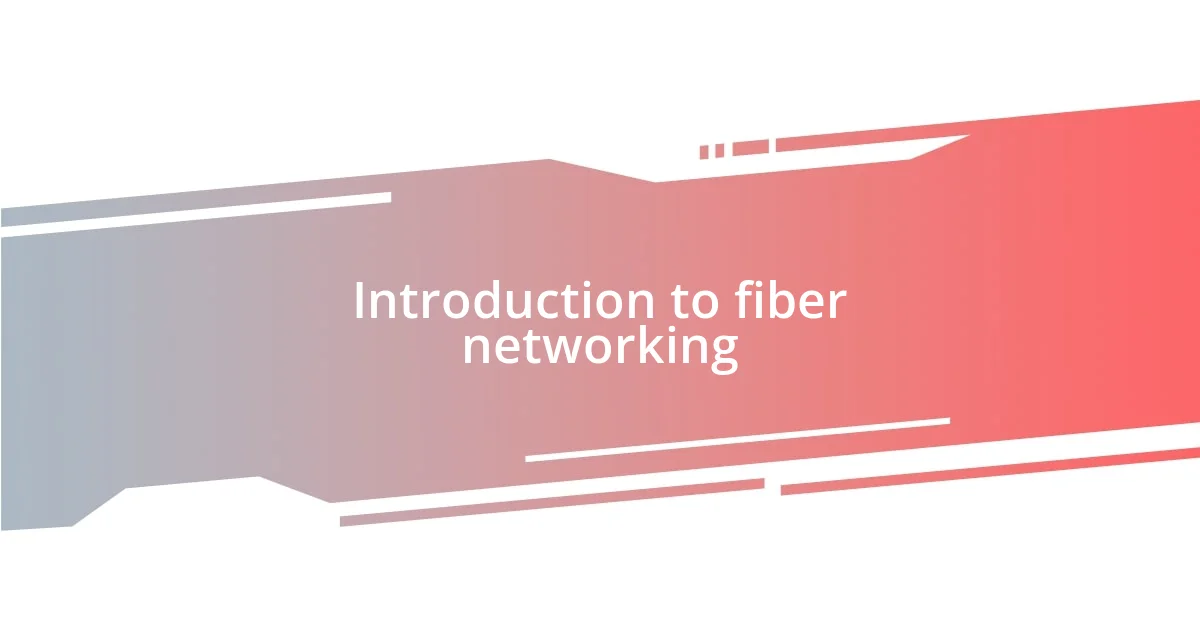Key takeaways:
- Fiber networking enhances speed, reliability, and bandwidth, transforming online experiences for both individuals and businesses.
- Understanding the differences between single-mode and multi-mode fibers is crucial for selecting the right type for specific networking needs and distances.
- Future trends in fiber networking include the integration of 5G technology, advancements in optical wireless communication (Li-Fi), and the use of artificial intelligence for network management.

Introduction to fiber networking
Fiber networking represents a crucial evolution in how we connect with one another and access information. When I first experienced the speed and reliability of fiber optics, it felt like I had stepped into the future. Have you ever been frustrated with slow internet during a crucial video call? Fiber networking can change all that, delivering high-speed connections that enhance our online experiences.
At its core, fiber networking relies on strands of glass or plastic that transmit data as pulses of light. This technology not only offers faster speeds but also significantly increases bandwidth for multiple users. I remember the first time I uploaded a large video file—it was astonishing how quickly I could share my work with friends and family. Doesn’t it feel empowering to have such capabilities at your fingertips?
As more households and businesses adopt fiber networking, the potential for innovation continues to grow. Imagine being able to stream 4K videos without buffering or participate in seamless virtual meetings from anywhere in your home. The excitement of fiber optics lies in its ability to transform our everyday activities, making the digital world more accessible and enjoyable for everyone.

Understanding fiber types and uses
When it comes to fiber types, understanding the difference between single-mode and multi-mode fibers is essential. Single-mode fiber features a small core, which allows light to travel in a single path, providing higher bandwidth and longer transmission distances. I remember setting up a connection for a client over a distance of several kilometers; single-mode fiber made that possible without any loss of quality. On the other hand, multi-mode fiber has a larger core, enabling multiple light paths but is typically used for shorter distances, like within a building.
Reflecting on how each type impacts networking, the choice often boils down to the specific needs of a project. For instance, if you want to connect different buildings in an educational campus, single-mode is my go-to option for speed and longevity. Conversely, when I worked on a network upgrade in an office setting, multi-mode fiber was the perfect fit for the shorter runs needed between rooms. This versatility is what makes fiber networking so interesting and tailored to various scenarios.
To highlight the differences in use cases more clearly, here’s a comparison table:
| Type of Fiber | Use Case |
|---|---|
| Single-Mode | Long-distance transmission (over several kilometers) |
| Multi-Mode | Short-distance transmission (inside buildings) |
Choosing the right type of fiber really does shape your networking experience, enhancing both performance and reliability.

Key benefits of fiber networking
One of the standout advantages of fiber networking is its unparalleled speed and reliability. I still vividly recall the moment I switched from a traditional broadband connection to fiber; the difference was transformative. Browsing became instantaneous, and downloading large files no longer felt like an eternity. This swift performance translates into more efficient work and hassle-free entertainment, which I believe everyone deserves.
Additionally, fiber optics boasts impressive bandwidth capabilities, allowing multiple devices to connect simultaneously without diminishing performance. This became particularly apparent when my family and I hosted a game night at home. Everyone was streaming their favorite games, and with fiber, we enjoyed lag-free connections. It’s remarkable how fiber can support multiple activities seamlessly, making it ideal for both busy households and bustling offices. Here are a few vital benefits:
- Ultra-Fast Speeds: Blazing fast download and upload times boost productivity.
- Higher Bandwidth: Support for numerous simultaneous connections without slowdowns.
- Reliability: Reduced disruption from weather and interference compared to other types of connections.
- Future-Proofing: Scalability to meet growing data demands as technology advances.
- Low Latency: Essential for online gaming and real-time communications.
The impact of fiber is profound; it not only meets our current needs but also prepares us for whatever comes next in the digital landscape.

Best practices for installation
When it comes to installation, proper planning is key. I often sketch out a detailed layout of the system before diving in—it’s like creating a roadmap for the project. Not only does this help identify potential obstacles, but it also ensures that every piece has its rightful place, leading to a smoother installation process.
Using the right tools is another critical best practice I’ve learned over time. Each fiber installation calls for specific tools, from fusion splicers to cable testers. I remember the time I improvised with standard tools instead of the proper splicing equipment—let’s just say it didn’t end well, and I spent more time redoing work than I had anticipated. Having the correct tools on hand not only saves time but also guarantees a professional finish.
Finally, testing everything is non-negotiable. Once I complete an installation, I always run tests to check the integrity of the connection. This step prevents headaches down the line when someone calls to complain about a slow connection. Trust me, getting it right the first time makes all the difference; it feels rewarding to know that I’ve done my best to provide a robust and efficient network from the outset.

Troubleshooting common fiber issues
When it comes to troubleshooting fiber network issues, one of the first things I check is the connections. A loose or damaged connector can easily disrupt the entire network. I remember a frustrating evening when my internet dropped out right before a big meeting; it turned out a connector hadn’t been seated properly. Checking connectors regularly can save you from a potential panic!
Another common issue I’ve encountered is signal loss, especially over longer distances. For instance, during a recent project, I noticed that my speed was significantly slower in one part of my home. After some investigation, I discovered the fiber run was too long without a signal booster. It made me wonder, how many people face similar issues without realizing the solution is just installing a booster? Investing in good equipment pays off in the long run.
Lastly, don’t overlook the importance of firmware updates. I once ignored an alert for an update on my router, thinking it wasn’t urgent. A few days later, I experienced frequent disconnections that interrupted my workflow. After finally updating the firmware, everything ran smoothly again. So, if you’re experiencing hiccups, check whether your hardware is up to date—it’s often the simplest fixes that yield the best results!

Enhancing performance with proper maintenance
Keeping up with maintenance is essential for maximizing the performance of your fiber network. I can’t stress enough how often I’ve found that a little preventive care goes a long way. For instance, I once neglected to clean my connectors regularly and was baffled by the intermittent connectivity issues that cropped up. Just a simple cleaning regimen brought everything back to life! It’s like giving your network the TLC it deserves.
Another aspect I’ve discovered is the importance of monitoring the network’s performance over time. This practice not only helps in identifying unusual patterns but also allows for timely adjustments. I remember a situation where my network started slowing down during peak usage. By keeping an eye on performance metrics, I noticed that a small router upgrade significantly improved user experience in my home. Doesn’t it feel good to take control of your network efficiency?
Lastly, regularly reviewing hardware conditions is something I’ve learned through trial and error. For example, I used to overlook the wear and tear on cables until one day, I encountered a complete failure during an important video call. That experience made me realize that proactively checking for damage before it becomes a bigger issue is critical. Are you giving your equipment the attention it needs? After all, a well-maintained network means less frustration and more productivity, wouldn’t you agree?

Future trends in fiber networking
One of the most exciting future trends in fiber networking is the advent of 5G technology, which relies heavily on fiber infrastructure. I can still remember the excitement I felt when I first learned how fiber optics support faster data transmission speeds and lower latency for mobile devices. With 5G rolling out across the globe, I can’t help but wonder how this will transform our daily lives. Picture a world where seamless connectivity enhances everything from remote surgeries to smart homes—impressive, right?
Another trend that intrigues me is the exploration of optical wireless communication, often referred to as Li-Fi. I first came across this technology at a tech seminar where the potential of using light to transfer data fascinated me. Just imagine, your next internet connection might not even need cables! This shift could revolutionize how we think about connectivity, especially in crowded places like stadiums or airports. Could this be the spark that makes our networks more resilient and efficient?
Lastly, I’m curious about the role of artificial intelligence in managing and optimizing fiber networks. I’ve experienced firsthand the struggle of predicting network demands, but I recently learned how AI algorithms can analyze traffic patterns and suggest adjustments in real-time. It’s almost like having a smart assistant dedicated to keeping everything running smoothly. As these technologies evolve, I can’t help but feel a thrill at the thought of our networks becoming more adaptable and self-sustaining. What do you think—are we ready for a future where our networks anticipate our needs before we even realize we have them?















